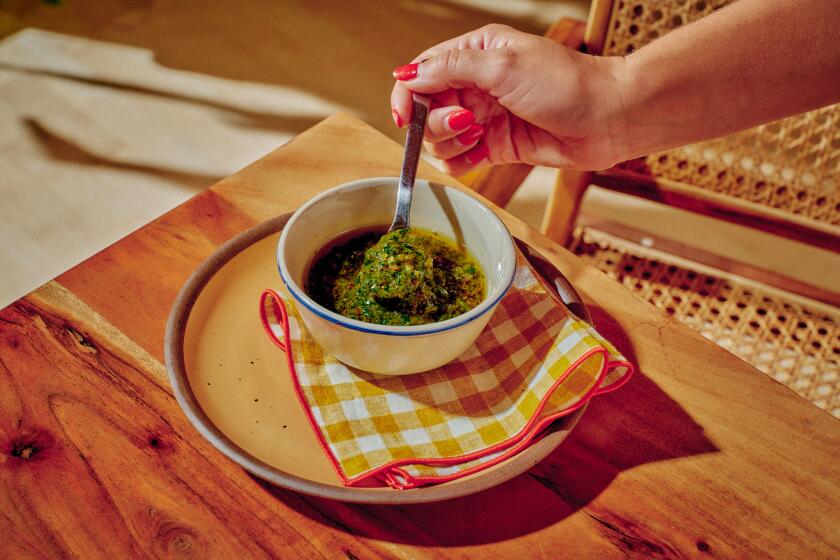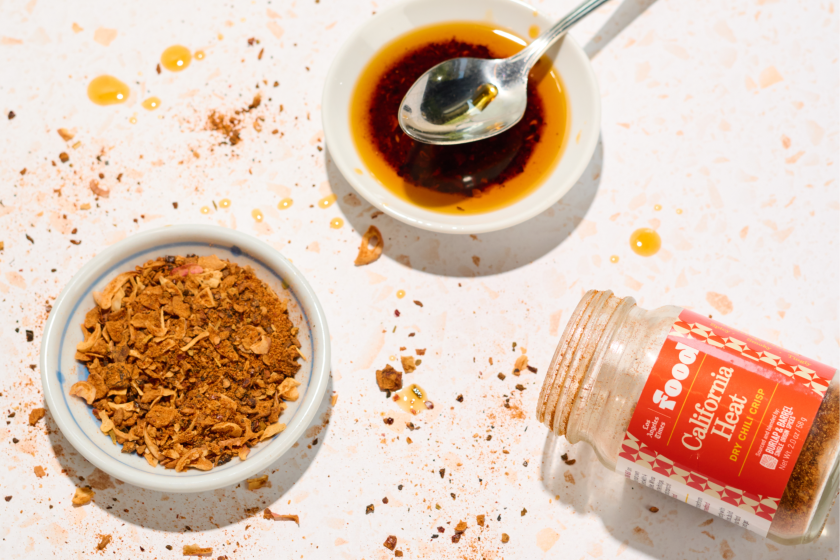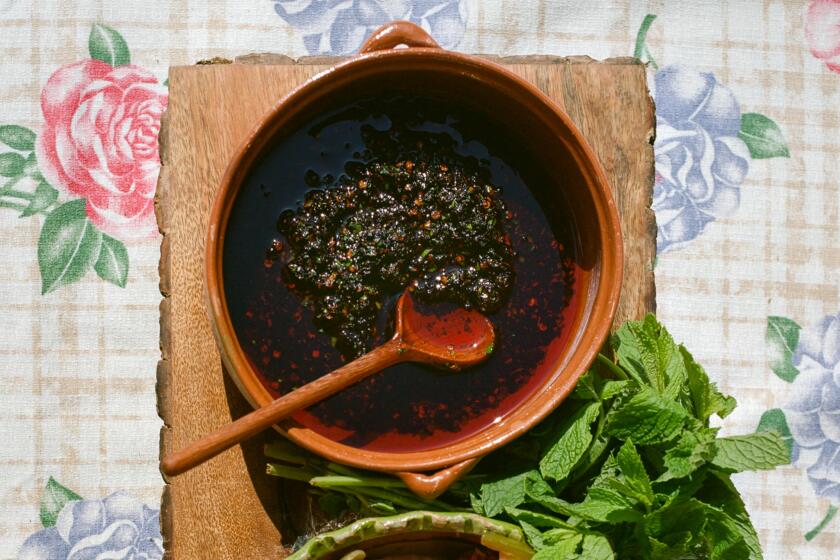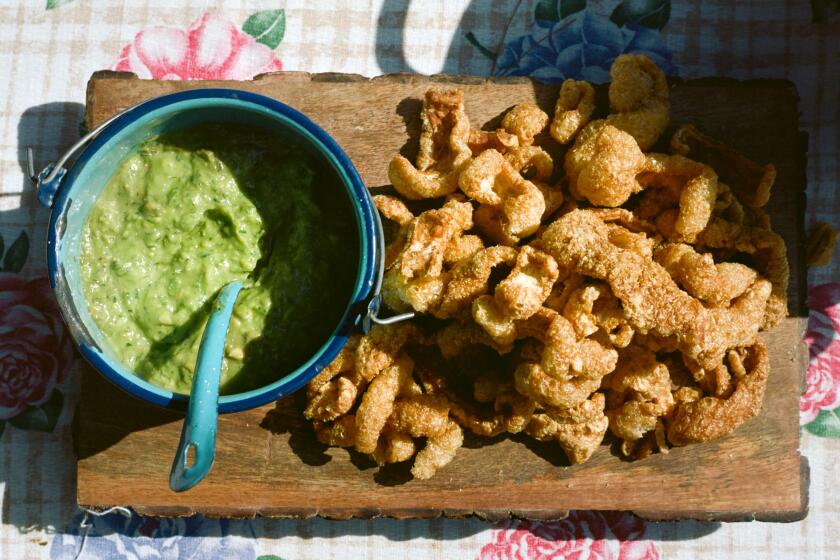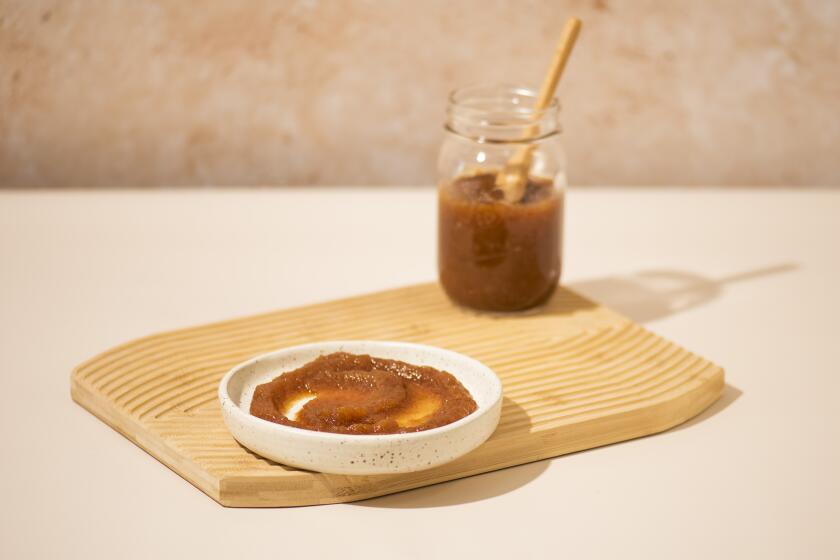Cucumber granita
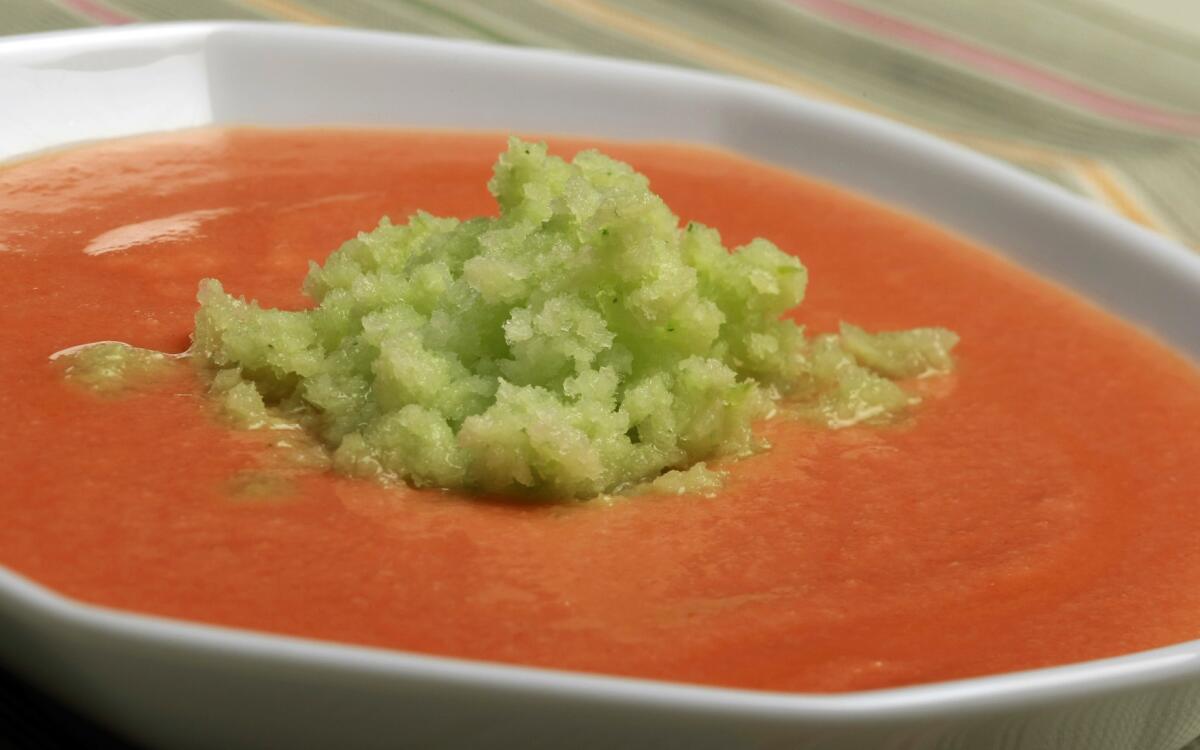
- Share via
Thursday is the feast of San Juan in my part of the world, a celebration of the start of summer that also traditionally marks the beginning of the gazpacho season. And just in time: My gazpacho garden is about to bear fruit.
Summer’s sun is turning the tomatoes crimson. They’ll soon be gloriously ripe and sweet. I’ve got the first crinkly, thin-skinned green peppers and fat cucumbers, as well as the onions and garlic harvested earlier. A jug of my own extra-virgin olive oil, a chunk of stale bread and tangy lemon juice complete the ingredient list for the season’s first gazpacho.
The recipe is ever so simple. I whirl the ingredients in a blender, sieve out the bits of skin and tomato seeds, thin the gazpacho slightly with cold water, then pour it into a tall glass and serve it neat -- no restaurant-style garnishes. My garden gazpacho is the perfect antidote to an Andalusian summer. Cool and refreshing, it’s a light lunch or an afternoon pick-me-up.
Gazpacho, in southern Spain, is older than tomatoes. It probably derives from a Roman dish, a simple gruel of bread and oil. The name “gazpacho” may come from the Latin caspa, meaning fragments or little pieces, referring to the bread crumbs that are an essential ingredient. The Moorish-Arabic influence is evident too, especially in some of the variations on the basic theme, such as a white gazpacho made with ground almonds.
None of those forerunners of gazpacho contained tomatoes, considered basic today. That’s because tomatoes were unknown in Spain until after the discovery of the New World.
Gazpacho belongs especially to Andalusia, southern Spain. Here day laborers working on big estates, in vineyards, olive plantations, citrus groves, wheat fields or cork forests received rations of bread and olive oil for their meals. Bread soaked in water made a simple soup, to which was added oil, garlic and salt for flavor, plus whatever fresh vegetables were available -- tomatoes, peppers and cucumbers in the summer. Everything was pounded together in a mortar or dornillo, a large wooden bowl.
Gazpacho provided nourishment, quenched the thirst and sustained a body working in the hot sun.
From these peasant beginnings, gazpacho has become quite the cosmopolite, appearing on the menus of sophisticated restaurants in many parts of the world. Recipes from abroad sometimes call for tomato juice, beef broth, ketchup or chile-hot salsa. Unfortunately, something is lost in the translation -- namely, the freshness of gazpacho made with raw ingredients.
This is not to say that you can’t experiment with the basic gazpacho. For instance, chopped basil -- which no self-respecting Andalusian housewife would add to gazpacho -- is a nice addition, and a dash of piquant Tabasco adds pizzazz.
Innovative chefs have had some fun with gazpacho, foaming it, gelling it, adding luxury ingredients such as shrimp and lobster. Chef Dani Garcia (his Marbella restaurant, Calima, has one Michelin star and his tapas venture, La Moraga, will open in Manhattan this year), makes a cherry gazpacho garnished with a drift of queso fresco “snow.”
Jose Andres, chef of the Bazaar restaurant in Los Angeles, attributes his very authentic gazpacho recipe to his wife, Patricia, who is from Andalusia. He jazzes it up by using yellow and green tomatoes in place of red ones. He also specifies sherry vinegar to give the soup its tang and, in one version, a bit of sweet oloroso sherry to balance the tartness.
If there is a single essential ingredient in gazpacho it is extra-virgin olive oil. The oil contributes flavor and, in combination with bread, turns the cold soup into a thick, creamy emulsion. Raw tomato puree is a reddish-pink in color, but the olive oil-bread emulsion turns it a pale, creamy orange.
Add even more bread in proportion to the tomatoes and omit the water and you achieve a thick gazpacho “cream,” called salmorejo or porra. Salmorejo is served in individual ramekins as a starter, garnished with thin strips of Serrano ham and chopped hard-cooked egg. It also makes a great party dip, accompanied by breadsticks and vegetable dippers.
White gazpacho
The basic oil and bread emulsion is also the starting point for white gazpacho, such as ajo blanco con uvas, literally, “white garlic with grapes.” Made with ground almonds, garlic, bread, olive oil and vinegar and garnished with grapes, this cold soup comes from the rich Moorish-Arabic heritage. More than the sum of its parts, ajo blanco is both unusual and delicious.
Another white gazpacho, made with pine nuts instead of almonds, is thickened with egg. And, for a non-traditional gazpacho, I use pureed avocados for the soup, with a garnish of diced tomatoes.
Speaking of garnishes, anyone who has visited Spain in the summer has likely sampled restaurant gazpacho, which usually is served accompanied with little dishes of chopped onions, peppers, cucumbers, tomatoes and croutons.
One year, when my garden produced an abundance of cucumbers, I invented a cucumber granita to garnish the gazpacho. Other authentic touches are sprigs of mint, chopped egg, chopped apple or melon. Flavorings are few -- salt, but no pepper -- garlic, cumin, sometimes sweet paprika -- but never hot chile.
Right temperature
How cold is a cold soup? Gazpacho in the fields was made with cool spring water. Even today, purists won’t put gazpacho in the fridge, as chilling damps down the sweetness and fragrance of fresh-picked tomatoes. I serve gazpacho, made with cold water, without further chilling -- but I refrigerate what’s left for enjoying at a later time. White gazpacho also can be served either room temperature or chilled.
I serve gazpacho in ceramic bowls, in mugs or, if diluted, in glasses. Think of it as “liquid salad,” to be served as a starter or alongside a main course.
Gazpacho goes especially well with fried fish, with omelets or with foods from the grill. It’s often served as a merienda, an afternoon pick-me-up or snack. I put chilled gazpacho in a Thermos to take on picnics, easy to serve in paper cups. Gazpacho or ajo blanco shooters are great tapa party fare.
A Spanish refrain says, “ De gazpacho no hay empacho”: There’s never too much gazpacho.
While my tomatoes are in season, I’m happy to serve gazpacho every day. By the end of summer, when the tomatoes are gone, I’ll be gathering almonds and cutting grapes to make ajo blanco. And, in the winter, there’s hot gazpacho with sour oranges -- but that’s another story.
Peel the cucumbers, cut them in half lengthwise and remove seeds. Cut the cucumbers into chunks. Puree the cucumbers in a blender with the lemon juice, onion, green pepper, salt, mint, oil and water. This makes about 2 1/2 cups puree.
Pour the cucumber puree into two 9-inch metal cake pans. Freeze.
To serve, remove the granita from freezer 5 minutes before serving. Use a fork to scrape the ice into mounds. Add the scraped ice to the gazpacho immediately before serving.
Get our Cooking newsletter.
Your roundup of inspiring recipes and kitchen tricks.
You may occasionally receive promotional content from the Los Angeles Times.










